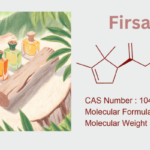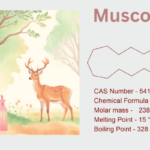1. Introduction: Ambrinol—The Synthetic Star of Amber Accords
Ambrinol is one of the few compounds in the complex field of scent chemistry that can truly express the mysterious charm of amber. A lab-born alternative to the scarce and ethically problematic ambergris, Ambrinol has become a cornerstone of amber and oriental scent combinations. With its warm, resinous, and subtly animalic character, this synthetic masterpiece bridges the gap between nature’s scarcity and human ingenuity. This article explains how science mimics nature’s most elusive treasures by examining ambrinol’s chemical synthesis, olfactory properties, and essential role in contemporary perfumery.
2. Chemical Identity: Decoding Ambrinol’s Molecular Blueprint
The main characteristics of Ambrinol (C₁₅H₂₆O), a synthetic terpenoid alcohol, are as follows:
- A 15-carbon skeleton with fused cyclohexane and decalin rings;
- Hydroxyl (-OH) and methyl groups, which improve solubility in alcohol and oil bases;
- Crystalline solid at room temperature, melting at 80–85°C;
Unlike molecules derived from natural ambergris, such as ambroxide, Ambrinol is completely synthetic and is made to replicate the dry, woody sweetness of aged amber without using animal-based ingredients.
3. Synthesis of Ambrinol: From Lab Bench to Luxury
Ambrinol’s manufacture focuses on terpene chemistry, utilizing cost-effective precursors to reproduce nature’s complexity:
Starting Material: β-Ionone
- Derived from citrus oils or synthesized via carotenoid oxidation.
- Serves as the aromatic backbone for cyclization.
Cyclization and Hydrogenation
- Acid-Catalyzed Cyclization: β-Ionone undergoes cyclization in the presence of sulfuric acid, forming a decalin framework.
- Hydrogenation: Palladium catalysts saturate double bonds, stabilizing the structure.
Hydroxylation
- Introduction of the hydroxyl group via oxidation (e.g., using hydrogen peroxide) or enzymatic methods (engineered yeast).
Purification
- Crystallization: Ethanol/water mixtures yield >99% purity.
- Chromatography: Removes traces of unreacted β-ionone.
This scalable, eco-efficient technology assures constant quality, free from the ethical and supply difficulties of real ambergris.
4. Natural Sources: The Ghost of Ambergris
Although Ambrinol is synthetic, its olfactory inspiration, ambergris, comes from the digestion of sperm whales. Aged ambergris contains ambrein, which oxidizes into aromatic chemicals like ambroxide, but Ambrinol provides a sustainable substitute because of CITES rules and ethical considerations.
Botanical Terpenes:
- Labdanum Resin: Although chemically different from ambrinol, a plant-derived resin (from Cistus ladanifer) has smokey, amber-like overtones.
5. Odor Profile: The Scent of Smoldering Elegance
Ambrinol’s aroma is a masterclass in balance:
- Top Notes: Subtle marine salinity, evoking ocean-weathered ambergris.
- Heart: Warm, resinous amber with hints of dry wood.
- Base: Creamy, musky undertones reminiscent of sun-baked skin.
It is a perfumer’s chameleon because of its adaptability, which enables it to accentuate both luxurious oriental accords and fresh aquatic ones.
6. Uses: Beyond the Perfume Bottle
Perfumery:
- Base Note: Extends longevity in luxury fragrances (e.g., Tom Ford’s Amber Absolute).
- Fixative: Stabilizes volatile top notes like citrus or bergamot.
- Accord Blending: Complements vanilla, patchouli, and oud in oriental compositions.
Cosmetics:
- Lotions and Creams: Adds a warm, skin-friendly base note.
- Candles and Diffusers: Provides a long-lasting, meditative aroma.
Functional Products:
- Detergents and Fabric Softeners: Masks chemical odors with a sophisticated dry-down.
7. Percentage in Fragrances: The Art of Moderation
Ambrinol’s potency demands precise dosing:
- Fine Fragrances: 0.5–2% of the recipe; it makes up about 1.5% of niche scents like Grand Soir by Maison Francis Kurkdjian.
- Cosmetics: 0.1–0.5% in leave-on products (creams, serums).
- Functional Products: <0.1% in detergents due to cost-intensity.
IFRA Guidelines:
- Perfumers limit usage at less than 3% to prevent dominating mixtures, but it is deemed safe with no particular limitations.
8. Challenges and Innovations
Sustainability:
- Bio-Based β-Ionone: Derived from fermented sugars using engineered microbes (e.g., Amyris).
- Solvent-Free Synthesis: Ionic liquids replace traditional solvents, reducing waste.
Market Competition:
- Analogues: Ambroxide and Norlimbanol have similar effects but lack Ambrinol’s resinous depth.
Future Directions:
- AI-Driven Formulation: Algorithms optimize Ambrinol blends for target demographics.
- Biodegradable Encapsulation: Enhances performance in eco-friendly products.
9. Conclusion: Ambrinol’s Timeless Resonance
As the industry shifts toward sustainability and ethical sourcing, this synthetic wonder ensures that the legacy of amber accords endures. As perfumer Olivier Cresp once said, “A great fragrance is a dialogue between memory and innovation.” Ambrinol, with its smoky warmth and lab-born precision, continues to whisper stories of both. Ambrinol’s journey from conceptual molecule to perfumery staple exemplifies the synergy of art and science.










